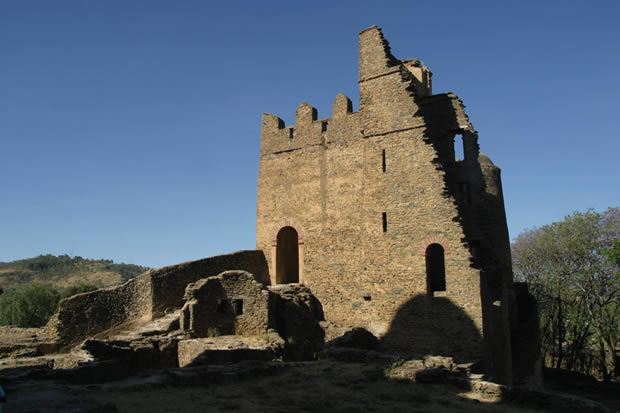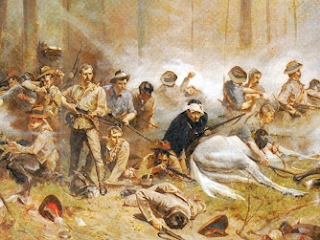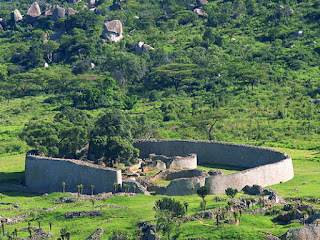 |
| Ancient Ethiopia |
Ethiopia is known to be one of the earliest places inhabited by humans. Bone fragments found in November 1994 near Aramis, in the lower Awash Valley by
Yohannes Haile Selassie, an Ethiopian scientist trained in the United States, have been connected with the Australopithecus afarensis, an apelike creature that lived some 4 million years ago, who may be an ancestor of modern humans. Subsequently, other bones were found attesting to the very early hominid activity in the country.
There are also stone hand tools and drawings from a much more recent period of prehistory in limestone caves near Dire Dawa, with the initial discoveries being made by H. Breuil and P. Wernert in 1923, further work in the late 1940s site by Frenchman H. Vallois, and then in the 1970s by Americans C. Howell and Y. Coppens. Work in the Awash Valley and also at Melka-Kunture, during the 1960s and early 1970s, was conducted by Jean Chavaillon, N. Chavaillon, F. Hours, M. Piperno, and others.
Another prominent anthropologist, Richard Leakey, has worked in the Omo river region of southwest Ethiopia and participated in much research in neighboring Kenya, where his father, Louis Leakey, was involved in many excavations.
It appears that some time between the eighth and sixth millennia b.c.e. people were beginning to domesticate animals, and archaeological evidence has shown that by 5000 b.c.e. communities were being formed in the
Ethiopian highlands, and it seems probable that the languages started developing at this time.
Linguists attribute an ancient tongue, based on the modern Afro-Asiatic (formerly Hamito-Semitic) languages, as developing later into the Cushitic and Semitic languages that are used today.
By 2000 b.c.e. evidence of
grain cultivation of cereals and the use of the plow, probably introduced from Sudan, and animal husbandry, have been found. It is believed people during this period would have spoken Geez, a Semitic language that became common in Tigray, which is believed to be the origin of the modern Amharic and also Tigranya.
There were many early links between ancient Ethiopia and Egypt starting with Piye, a ruler of the Fifth Dynasty in Egypt (2500 b.c.e.), and there were occasions when the two countries were recorded as having the same ruler, whose capital was at Napata, north of modern-day Sudan.
Indeed, Pharaoh Sahure sent a voyage to the land of Punt during the Fifth Dynasty, and most scholars believe that this represents a part of modern-day Ethiopia, although some place Punt as being in modern-day Yemen or even as far south as Zanzibar, or even the Zambezi. This expedition sent by Sahure returned with 80,000 measures of myrrh; 6,000 weights of electrum, an alloy made from silver and gold; and 2,600 “costly logs,” probably ebony.
The most famous expedition to Punt was that led by Queen Hatsehpsut in about 1495 b.c.e., according to inscriptions detailing it that have been found on the temple of Deir el-Bahri in Thebes. The carvings show traders bringing back myrrh trees, as well as sacks of myrrh, incense, elephant tusks, gold, and also some exotic animals and exotic wood.
Da’amatFrom about 800 b.c.e., several kingdoms started to emerge in Ethiopia. The first was the kingdom of Da’amat, which was established in the seventh century b.c.e. and dominated the lands of modern-day western Ethiopia, probably with its capital at Yeha.
A substantial amount about Yeha is known, owing to the excavations of Frenchman Francis Anfray in 1963 and again in 1972–73, as well as work by Rodolfo Fattovich in 1971. Much of the early work of the former was concentrated in rock-cut tombs, with the latter working extensively on pottery fragments.
From their work and the work of other archaeologists it was found that Yeha was an extensive trading community, well established in the sale of ivory, tortoiseshell, rhinoceros horn, gold, silver, and slaves to merchants from south Arabia. It also seems to have had close links with the Sabaean kingdom of
modern-day Yemen, as all the surviving Da’amat inscriptions refer to the Sabaean kings.
The kingdom of Da’amat used iron tools and grew millet. It flourished for about 400 years but declined with the growing importance of other trade routes and possibly due to the kingdom not being able to sustain itself, having killed many of the animals in its region and possibly exhausted the mines.
Substantial archaeological work has been carried out on this period of Ethiopian history with one search by Jean Leclant in 1955–56, finding two sites at Haoulti-Melazo with a statue of a bull, incense altars, and some fragmentary descriptions.
AxumThe next kingdom, which gradually took over from Da’amat, was the kingdom of Axum (Aksum), from which modern Ethiopia traces its origins. The large temple at Yeha dates to 500 b.c.e., and scholars question whether it was built by the kingdom of Da’amat or that of Axum.
Axum may have emerged from 1000 b.c.e., but it was not until 600 b.c.e. that it become important. Like Da’amat, it also relied heavily on trade with Arabia, forming a power base in Tigray, and controlling the trade routes from Sudan and also those going to the port of Adulis on the Gulf of Zula. The
kingdom of Axum used Geez as its language, with a modified south Arabian alphabet as their script.
Indeed, so much of Axum’s architecture and sculpture are similar to earlier designs that have been found in South Arabia as to suggest to some historians that the kingdom might have been largely established by people from Arabia. This is reinforced by the fact that Axum also used similar deities to those in the Middle East.
During the eighth century b.c.e. it is thought that Judaism reached Ethiopia—the modern-day Falashas are the descendents of the Ethiopian Jews. It seems likely that Jewish settlers from Egypt, Sudan, and Arabia settled in Ethiopia, but attempts to link them chronologically with a specific biblical event such as Moses leading the Jews from Egypt or the Babylonian Captivity have not been successful.
In this debate exists the legend of the queen of Sheba. She was known locally as Queen Makeda and is believed to have ruled over an area of modern-day southern Eritrea and was involved in a pilgrimage to Jerusalem.
There she met the Israelite
king Solomon, and they may have had an affair that led to the birth of a son who became Menelik I, the ancestor of the Ethiopian royal house that ruled the country until 1974, although this rule was interrupted by the Zagwe dynasty.
Certainly the dynasty tracing their ancestry from Menelik calls itself the Solomonic dynasty. One version of the legend includes Menelik I returning to Jerusalem where he takes the Ark of the Covenant, which some believe is still in Ethiopia.
By the fifth century b.c.e. Axum had emerged as the major trading power in the Red Sea, with coins minted bearing the faces of the kings of Axum being widely distributed in the region.
Mani (216-c. 274 c.e.), the Persian religious figure, listed the four great powers during his life as being Rome, Persia, China, and Axum. During the third century b.c.e. Ptolemy II and then Ptolemy III of Egypt both sent expeditions to open up trade with Africa and, it has been suggested, also to obtain a source of war elephants for the battles against their rival, the Seleucid Empire.
The latter tended to gain a military advantage by using Indian elephants, with the Ptolemies using either Indian elephants or North African elephants, which are smaller than Indian elephants. Although the Ptolemies soon stopped sending missions to the Red Sea and beyond, trade relations continued.
The Roman writer Pliny, writing before 77 c.e., mentioned the port of Adulis, and the first-century c.e. Greek travel book Periplus Maris Erythraei describes King Zoskales living in Adulis—then an important trading destination and the port for the kingdom of Axum—as being the source for ivory taken from the hinterland to the capital of Axum, eight days inland from Adulis. Zoskales in Adulis was described as “a covetous and grasping man but otherwise a nobleman and imbued with Greek education.”
The writer of Periplus Maris Erythraei also notes that there was a large number of Greco-Roman merchants living at Adulis, and it seems likely that it was through them that the ideas of Judaism and then Christianity started to flourish.
The arrival of Christianity in Ethiopia is ascribed to Frumentius, who was consecrated the first bishop of Ethiopia by Athanasius of Alexandria in about 330 c.e. He came to Axum during the reign of the emperor Ezana (c. 303–c. 350), converting the king as is evident in the design of his coins, changed from an earlier design of a disc and a crescent.
This meant that the Monophysite Christianity of the eastern Mediterranean region was established firmly in Axum during the fourth century, and two centuries later monks were converting many people to Christianity in the hinterland to the south and the east of Axum.
The Christianity in Axum became the Ethiopian Orthodox Church, heavily influenced by the Egyptian Coptic Church. The last stela at Axum, late in the fourth century, mentions King Ouszebas.
At its height Axum not only dominated the Red Sea in areas of commerce but even held land controlling the South Arabian kingdom of the Himyarites in modern-day Yemen, with King Ezana described on his coins not only as “king of Saba and Salhen, Himyar and Dhu-Raydan” but also “King of the Habshat”—all these places being in South Arabia. He had also, by this period, adopted the title negusa nagast (“king of kings”).
On the African continent their lands stretched north to the Roman province of Egypt and west to the Cushite kingdom of Meroë in modern-day Sudan. Indeed, it seems that the forces of Axum had captured Meroë in about 300 c.e.
However, during the reign of Ezana it experienced a decline in fortune but regained its former strength over the next century. This is borne out by the few inscriptions that survive, which were either in Geez or in Greek.
Axum’s DeclineWhen Christians were attacked in Yemen in the early sixth century, Emperor Caleb (r. c. 500–534) sent soldiers to prevent them from being persecuted by a Jewish prince, Yusuf Dhu Nuwas, who attacked the Axum garrison at Zafar and burned all the nearby Christian churches. This represented a time when Axum was probably at its height in terms of its power and diplomatic connections.
The Book of the Himyarites revealed previously unpublished information about Caleb’s attack on Yemen. King Caleb spent his last years in a monastery, but by this time Axum was in control of land on both sides of the Red Sea and was in regular communications with the Byzantine Empire at Constantinople.
Axum’s power waned when the
Sassanid Empire invaded the region in 572. Although it is not thought that the Sassanids conquered the kingdom of Axum, they probably did defeat its armies in battle and certainly cut off its trade routes not only to Arabia but also into Egypt, thus ensuring its gradual decline.
The political influence of Axum had ended, and the city would have declined. Some 30–40 years later the whole of South Arabia and also Egypt were controlled by the Arabs, cutting off the connections between Axum and the Mediterranean.
















